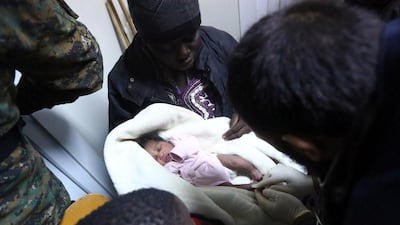European Union leaders have agreed on a strategy to combat migrant-smuggling from Libya, which is now at record levels, but its success hinges on a resolution to the country’s civil war.
Last year 181,000 migrants crossed the Mediterranean from Libya to Italy and Malta, and more than 5,000 drowned on the voyage. Both figures were higher than in any year previously.
On Sunday, Libyan coastguards rescued more than 120 migrants, including women and children, off the coast of Tripoli after their boat ran into trouble.
EU leaders issued the Malta Declaration on Friday, setting out a two-pronged strategy to bolster Libya’s coastguard and improve migrant camps in Libya, the aim being to end the perilous flow of people.
European Council president Donald Tusk said Libya’s coastguard would become the chief mechanism for stopping people smugglers who send migrants across the Mediterranean in flimsy boats.
“We will train, equip and support the Libyan coastguard to stop people smugglers and increase search and rescue operations,” Mr Tusk said at the summit in Malta.
Meanwhile, a €200 million (Dh792m) programme will focus on funding Libyans to care better for tens of thousands of migrants who have arrived in hoping for passage to Europe.
But humanitarian organisations doubt either operation can succeed because Libya’s authorities remain too chaotic to get a grip on the situation.
Medecins Sans Frontieres, which operates rescue boats off the Libyan coast, described the EU plan as “madness”.
The organisation tweeted: “With their ‘Malta Declaration’ the EU Council shows how utterly delusional they are about the situation for migrants & refugees in Libya.”
Last week, the German embassy in Niger issued a report describing the grim situation in Libyan migrant detention camps, including “executions of countless migrants, torture, rapes, bribery and banishment to the desert on a daily basis”.
Human Rights Watch called for the EU to demand that Libyan authorities end cruel practices, highlighting similar findings in a December report by the United Nations high commissioner for refugees.
Libya has become the channel for the largest number of migrants heading to the EU, a position Turkey held in 2015, when the EU borders agency, Frontex, said 764,000 crossed into Europe.
That number fell to 123,000 last year following a deal in March under which the EU agreed to give Turkey financial aid in exchange for keeping migrants — most of them fleeing Syria — on Turkish soil.
Last week Italy, backed by Malta, signed a memorandum of understanding with Fayez Al Serraj, head of the Tripoli-based Government of National Accord (GNA), paving the way for a similar migrant repatriation deal.
But human rights groups say Libya is not a safe place to send migrants, with war raging and ISIL a continuing presence.
For the moment, the EU has held off on approving Italy’s request for a migrant return deal with Libya, hoping its current policies can end the people-smuggling trade.
The EU has deployed warships off Libya since June 2015 as part of Operation Sophia, both to rescue migrants and intercept smugglers.
Operation Sophia says it has arrested 44 smugglers and captured more than 80 boats since then. But a report from Britain’s House of Lords last May, titled “Operation Sophia: An Impossible Challenge”, said EU craft had “no meaningful impact” on migrant smugglers.
The bigger problem is Libya’s chaos, and the inability of the GNA to control all-powerful militias in western Libya who operate the migrant trade.
Eastern Libya has its own interim government, which does not recognise the GNA.
A long-term solution is likely to depend on an end to the country’s political rift, but with forces of the two governments now battling each other in central and southern Libya, unity appears a long way off.
foreign.desk@thenational.ae
*With additional reporting from Agence France-Presse

